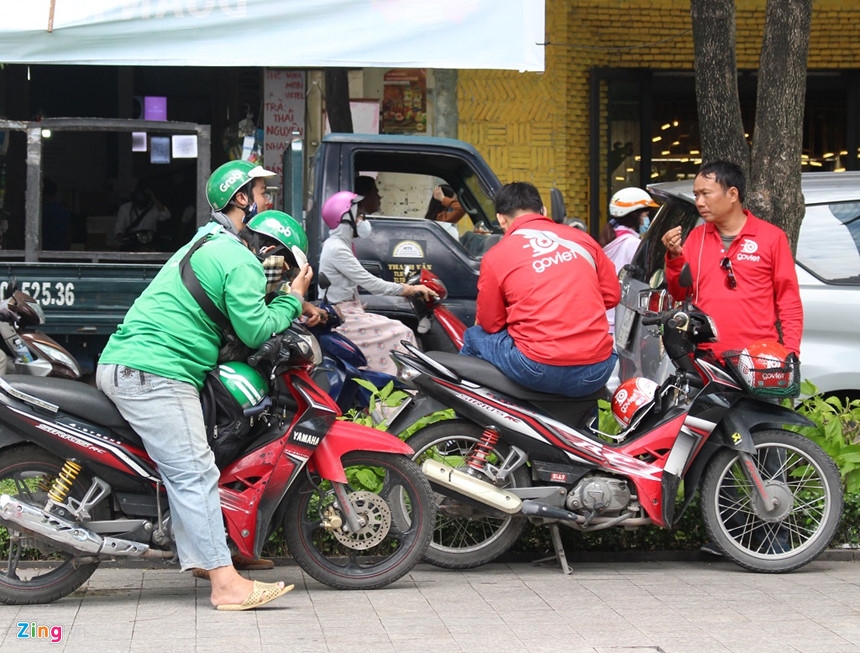Ride-hailing firms struggle to sustain price war
 |
| Go-Viet and others tried undercutting Grab's prices and are now struggling to stay afloat, photo Zing .vn |
Over the past few years, Vietnam has witnessed the explosive growth of ride-hailing in the biggest cities, which critics say has flooded the streets with motorcycles. The red and green uniforms of Go-Viet and Grab drivers are ubiquitous in the streets. Meanwhile, Vato and FastGo drivers can also be spotted with their orange and blue uniforms.
After launching, many ride-hailing firms rely on promotions and low fares to expand in Vietnam. However, analysts warn that this strategy is not sustainable. Many firms have been struggling and failed to acquire sufficient market share. It is easy to notice that the number of drivers of Go-Viet, Vato, and FastGo have been on the decline in recent times.
During its beta launch in Vietnam last year, Go-Jek undercut Grab’s fares and promotions. The firm quickly gained market share, however, it is now facing a growth challenge with many complaints from drivers. Some drivers even quit when the company introduced a commission rate of 20 per cent (it was initially zero).
Take the price for example – GrabBike charges VND27,000 for a ride of nearly 4 kilometres. Meanwhile, Go-Viet’s average fare for the same ride is VND13,000. Given that they charge the same commission rate, Go-Viet drivers’ income is far lower than Grab drivers’.
In addition to the falling income, Go-Viet’s drivers are challenged by the company tightening its driver management policy. It means they have to work harder to improve their daily performance to earn rewards from the ride-hailing firm. Also, drivers are more likely to be suspended if they cancel three bookings within one hour.Another issue is that some features of the ride-hailing app are not fully completed, making it hard for Go-Viet’s drivers to navigate to destinations.
The CEO and another top-level executive of Go-Viet have already resigned over this issue, according to sources familiar with the company. The change of top-level personnel also raises questions about the sustainable development of the company.
Meanwhile, Grab seems to gaining the upper hand in the competition. After five years of operations in Vietnam, Grab has become the leader in on-demand transport. The ride-hailing firm has recorded double-digit growth in the number of rides.
In addition, Grab has expanded beyond personal transport into food delivery, parcel delivery, and digital payment. According to GrabFood, Vietnam is its second fastest growing market for food delivery in the region. Meanwhile, Grab also unveiled its e-wallet system GrabPay by Moca in late November after forming a strategic partnership with Moca.
In March, Grab secured over $4.5 billion in funding in its latest financing round from Softbank Vision Fund (SVF). This capital injection brings the total financing secured in Grab’s current Series H round to over $4.5 billion.
In the same month, Go-Jek has picked up $100 million in fresh capital as part of its ongoing Series F funding round, where the company aims to raise at least $2 billion. The latest influx of cash has come from existing investor Astra International, an Indonesian conglomerate.
Meanwhile, Vato launched in May after being rebranded from Vivu Technology Development JSC. It received $100 million in investment from Phuong Trang Tourism Service and Transport JSC, according to Vato’s founder Tran Thanh Nam.
FastGo is also aiming to raise another $50 million in its Series B investment round over the next few months, after receiving an undisclosed sum in a Series A investment from venture capital platform VinaCapital Ventures in August.
Analysts say that the competition in ride-hailing is of a similar nature to e-commerce. Initially, there are a lot of small- and medium-sized players and a few significant ones. As the market shows sustainable growth, the challenge is to stay in the game and continue growing, and ideally to be faster than the market itself.
Investors inject money in the platforms as they believe in the growth potential and the future profitability of the business. The ride-hailing firms which have sustainable development strategies and strong capital backup might win the battle of dominance in Vietnam.
What the stars mean:
★ Poor ★ ★ Promising ★★★ Good ★★★★ Very good ★★★★★ Exceptional
Related Contents
Latest News
More News
- First members of Danang International Finance Centre revealed (December 22, 2025 | 17:39)
- Human-centred governance seen as key to AI development (December 19, 2025 | 18:19)
- Top 10 notable events of Vietnam’s industry and trade sector in 2025 (December 19, 2025 | 14:00)
- Tungsten surges to 12-year high as world enters a new 'black gold' race (December 18, 2025 | 17:27)
- Vietnam’s coffee exports set new record despite price pressures (December 18, 2025 | 17:13)
- Garment and textile sector seeks new growth after volatile year (December 18, 2025 | 17:01)
- VinSpeed and Siemens strengthen cooperation for high-speed rail development (December 18, 2025 | 16:53)
- High-tech adoption for TH true MILK (December 18, 2025 | 13:39)
- Takeda supports health resilience amid climate change challenges (December 18, 2025 | 12:39)
- Mondelez Kinh Do - a chapter of purpose-led leadership in Vietnam (December 18, 2025 | 09:44)

 Tag:
Tag:






















 Mobile Version
Mobile Version